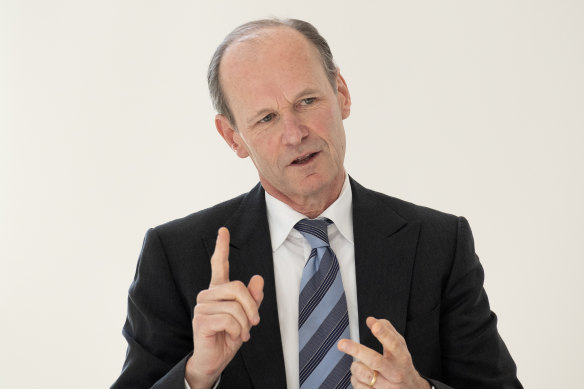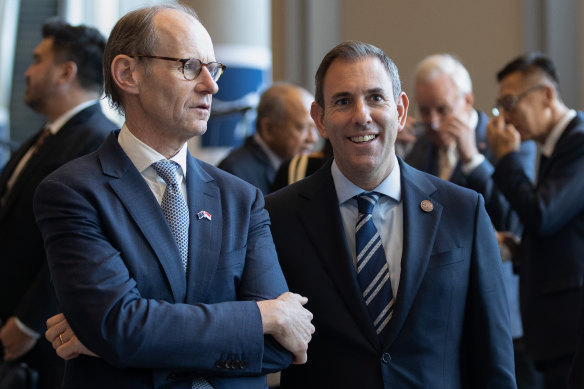- Exclusive
- Business
- Banking & finance
- Big four
The big four bank boss who says there’s more room for risk
By Millie Muroi
ANZ chief executive Shayne Elliott says cautious lending standards are taking a disproportionate toll on younger generations, arguing banks should be allowed to take more risk in their loans to property developers and first home buyers.
ANZ’s largely affluent customer base has mostly muddled through the high-interest rate environment, but Elliott is attuned to the need to make housing more affordable as cost-of-living pressures squeeze many, especially outside the main banks.

ANZ chief executive Shayne Elliott.Credit: Jeremy Piper
If it were up to him, existing regulations would allow banks to take on more risk. But he also acknowledges major banks could rethink their risk appetite within existing bounds. “We have to be more open-minded,” he says.
As house prices grind higher, Elliot is concerned increasing swaths of Australians and New Zealanders are being locked out of the financial system and the housing market.
Speaking in the bank’s head office in Melbourne last week, Elliott argued there’s a case to be made for letting banks take more risk – both in their lending to big business clients, as well as first home buyers.
“If we restrict credit, it does come at a cost,” he says. “Certain parts of the community pay a higher price than others, and one of them is the younger cohort, particularly those who have an aspiration to buy a home.”
The comments on housing and risk – a long-running theme for Elliott – came as the bank also sought to respond to allegations of cultural problems in its markets division.
On Thursday, in an internal note to staff, Elliott said the allegations reported in the media were not new and that the bank was treating them with “utmost seriousness”, including engaging external legal counsel to assist in its investigations.
Elliott flags that one area where the bank could allow more risk is in its institutional bank, where it lends to some of the country’s biggest businesses, therefore having a role in the supply side of housing.
Australian Prudential Regulatory Authority (APRA) chairman John Lonsdale last month said this was not the time to wind back the clock on banking regulation. But at the same time, Lonsdale also said there was scope for banks to increase their own risk appetite.
‘Certain parts of the community pay a higher price than others, and one of them is the younger cohort, particularly those who have an aspiration to buy a home.’
Shayne Elliott, ANZ chief
Elliott says the bank could lend money for more affordable housing models such as “build to rent to buy” (BtRtB), where a community housing provider is the developer for a property, charging lower-than-market rent until the tenant has saved enough for a deposit to buy the property they are renting.
UNSW housing research professor Hal Pawson says it’s a model that helps those who earn below a certain income level to save for a deposit through not only lower rent, but also a longer-term contract that eliminates the constant moves often required in the private market.
“The BtRtB model seeks to help potential first home buyers who might otherwise be locked out of the market to transition over a period to full homeownership,” he says.
That model also can reduce the cost of building houses because of the lower financing costs and tax benefits that can be given to not-for-profit community housing developers.

Shayne Elliott says the bank could lend money for more affordable housing models such as “build to rent to buy”.Credit: Darrian Traynor
Elliott says the bank is already taking a closer look at this model.
“We can help [builders] drive down the cost of construction, and the way we do that is by taking more risk and being prepared to take different risk,” he says.
This modified risk appetite could also apply to how the bank assesses home loan applicants, Elliott says, although he is wary of acting only on the demand-side, which could worsen housing affordability.
“We have to be thoughtful about how we assess risk for first-home buyers,” he says, noting the current standards are a result of both regulation and prudent thinking by banks.
“If you came into the bank, or any bank, and decided to borrow money, we would look at your income today and assume you never get a pay rise for 30 years, which is kind of a ridiculous assumption,” he says. “We make all sorts of assumptions about your current position that probably aren’t terribly relevant, or terribly true.”
As an example, Elliott says there’s a question around whether banks should be more generous in their assumptions of people’s income and factor in future increases.
But he also thinks there could be a change to the serviceability buffer, a stress test required by APRA that adds a 3 percentage point “buffer” to the rate of a loan to determine eligibility.
Last year, Elliott backed the 3 per cent buffer, saying it “feels about right”. But his views have since changed.
“I’m not sure [the serviceability buffer] makes sense today, given where interest rates are today,” he says. “You would imagine as rates rise, the buffer would come down, and as rates lower, the buffer would go up. I think 3 per cent is probably a bit burdensome at the moment. A number more like two is probably more reasonable.”
Elliott is under no illusion that such a tweak would bring about significant change: “But for some, particularly first home buyers, I think it would make a difference, and I think that’s a reasonable risk to take.”
It comes as Australians have come under increasing pressure amid cost-of-living pressures and high interest rates. Major bank customers have largely increased their savings buffers, benefiting from higher returns on their deposits, but Elliott says there are some signs of stress, especially in certain segments of the bank’s institutional customers.
“Our [retail and small business] customers have definitely increased their savings buffers, which is staggering, actually,” he says. “The big end of town in general is doing really well so we’re seeing remarkably low stress. Where the stress is, is probably more in the middle market, so more private and domestic companies. The obvious ones have been in construction, and the other area is discretionary retail.”
Elliott is also gearing up to execute the biggest bank merger in more than a decade. Last week, ANZ’s deal to merge with Suncorp Bank cleared its final hurdle: a change to Queensland’s merger legislation.
The deal has been two years in the making, and not until Treasurer Jim Chalmers signed off on it last month could Elliott breathe a sigh of relief.
“We were playing high-stakes poker,” Elliott said of the $4.9 billion merger. “The unknown, obviously, was the treasurer. Once [his approval] came through, that was the only time I was totally confident.”
Elliott is acutely aware of the historically challenging process of steering a successful bank merger.
“It’s not a walk in the park from here,” he says. “We’ve spent material time – and I don’t just mean a phone call – with at least 10 global banks which have done mergers or integrations that look like this, and tried to instil all those experiences.”
Elliott says the biggest challenge will be moving customers and staff across from Suncorp to ANZ without “scaring the horses”. He says he will do this by keeping Suncorp’s products and brands in place for some time before convincing them to come under ANZ’s products and services.
Despite challenges, including cost-of-living pressures, signs of a weakening jobs market and the risk of a recession, Elliott is optimistic. “Working at a bank is just managing a series of crises,” he says.

Shayne Elliott with Jim Chalmers at the ASEAN-Australia Special Summit 2024 in Melbourne in March.Credit: Arsineh Houspian
During previous crises, banks have been in survival mode, Elliott says, pulling back lending and “making things worse at a system level”. This time, he says the “crisis” is slightly different.
“Banks are in really good shape,” he says. “[They have] lots of capital, lots of liquidity, so banks are actually in a position to help and support [borrowers], which suggests that we should be able to get through this crisis.”
The Business Briefing newsletter delivers major stories, exclusive coverage and expert opinion. Sign up to get it every weekday morning.